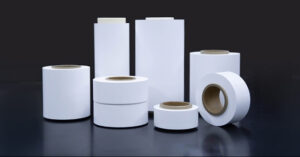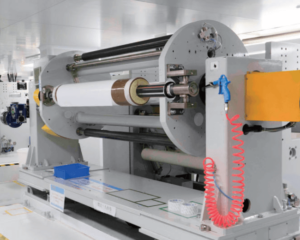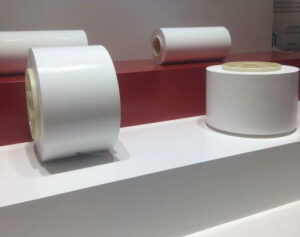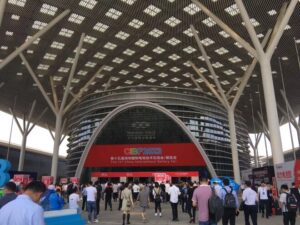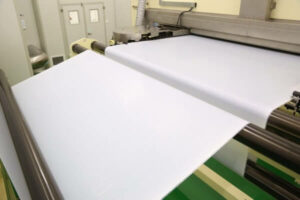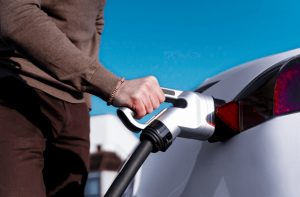Ceramic coated battery separator is widely used in many industrial applications because of their wear resistance, chemical resistance, and thermal properties.
As one of the four main materials of lithium-ion batteries, battery separators play a vital role of separators in battery manufacturing. Currently, almost all NCM system batteries use ceramic-coated separators for power batteries. The PP or PE base films are coated with a nano-scale Al2O3 layer. Ceramic coating can significantly improve the thermal shrinkage, oxidation resistance, and puncture strength of the separator and the wettability of the ceramic layer’s porous structure, which brings many benefits to the battery.
With years of development, Al2O3 has become the most popular ceramic coating material, benefiting from the mature ceramic coating technology. Although there are other functional coatings on the market, why do most manufacturers coat ceramic particles on battery separators? This article will analyze the reasons for coating the ceramic layer by comparing the safety and electrical properties of regular PE separators and ceramic-coated PE separators. This article can also help guide enterprises in selecting better-quality battery separators.
The process of ceramic coated PE separators
The first step in the Al2O3 ceramic coating process is to prepare ceramic slurry by mixing Al2O3 particles with PVDF and polyurethane. After that, the ceramic slurry will be printed on the surface of the PE or PP base films with the auto gravure printing machine (both dry process and wet process ceramic coated battery separator).
The PVDF and polyurethane jointly play the role of the binder so that Al2O3 particles can be firmly stuck to the surface of separators. Thus, the PE films maintain good shrinkage resistance even at 200 °C. At present, it is more common to coat ceramic layers on one or both sides of the separators with a thickness of 2-4um.
Compared to regular base films, the ceramic coating improve the separator’s mechanical strength, so the battery still maintains excellent performance in high-temperature, puncture, and thickness reduction. At the same time, it does not affect air permeability, ensuring lithium ions’ flow and thereby improving safety.
Porosity and Gurley
Ceramic coating can improve the separator’s porosity, which enhances the liquid retention and wettability of the separator, therefore improving the lithium batteries’ cycle life.
To compare the difference between ceramic coated PE separators and ceramic-free PE separators, the researchers applied a 1.3 μm thickness coating layer on the surface of 18 μm thickness PE separators.
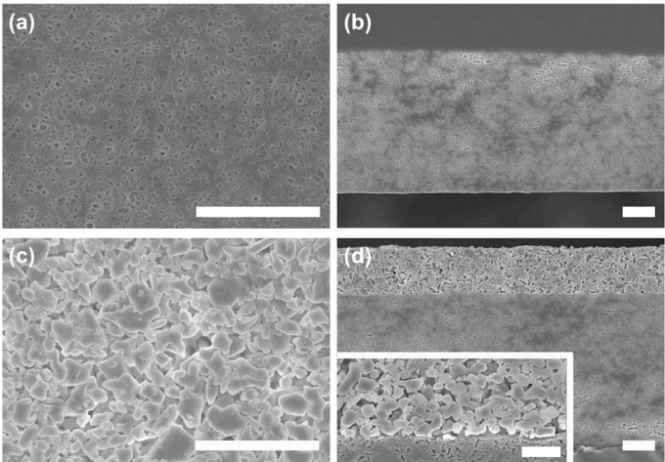
Comparison of PE separators (a-b) and Al2O3 ceramic coated separators (c-d) SEM images. The scale is 3 μm in the large image and 1 μm in the local magnification.
The results show that the thickness of the ceramic coating is applied very homogeneously and uniformly. In the meantime, the electrolyte permeability test showed that the Gurley number of the PE separator was 184 s/100 mL. In contrast, the Gurley number of the Al2O3 ceramic coated battery separator was 250 s/100 mL, indicating that the ceramic coating did not block the PE base film’s pores or significantly affect the diffusion transport of lithium ions. Conversely, the ceramic coating makes the pores of the separators more uniform.
Excellent thermal shrinkage
Despite the porosity and Gurley, the ceramic coating can also improve the thermal stability and mechanical strength of the PE separator. The ceramic coating greatly prevents the large-scale contact of positive and negative caused by the shrinkage of the separator. As a result, it greatly improves the safety performance of lithium batteries.
To test the heat shrinkage resistance of the ceramic-coated PE separators and ceramic-free PE separators, the researchers placed both separators in an oven at 200 °C for 10 minutes. The test shows the shrinkage rate of PE diaphragm MD/TD direction was 75%/76%. Surprisingly, there was almost no shrinkage for the Al2O3-coated PE separators. The excellent heat shrinkage resistance of the ceramic-coated separators is beneficial from the low coefficient of thermal expansion of Al2O3 ceramic coating and the excellent binder performance of polyurethane and PVDF.
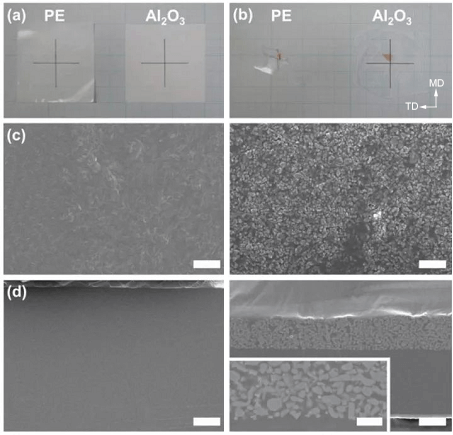
Figure 2. (a-b) Comparison of the appearance of ceramic-free PE separators and Al2O3 ceramic-coated PE separators before and after being placed at 200 °C for 10 min. (c) surface SEM image; (d) Cross-sectional SEM image.
Shutdown and melting properties
The heat shrinkage resistance test of both separators is carried out without electrolytes, which cannot simulate the real environment in the battery. To ensure the accuracy of the test, the researchers compared the shutdown and melting properties of the two separators in the LiPF6/PC environment. The results show ceramic-free PE separators shut down at about 135 °C, and the resistance value continues to rise with the uprising temperature. Finally, the PE separators melt at about 145 °C, and the resistance value drops extremely.
The shutdown temperature of the Al2O3-coated PE separators is slightly higher than 135 °C, but the resistance value of the ceramic-coated PE separators remained unchanged even above 145 °C. The above results show that Al2O3 ceramic particle coating can greatly improve the separator’s heat shrinkage resistance and mechanical properties.
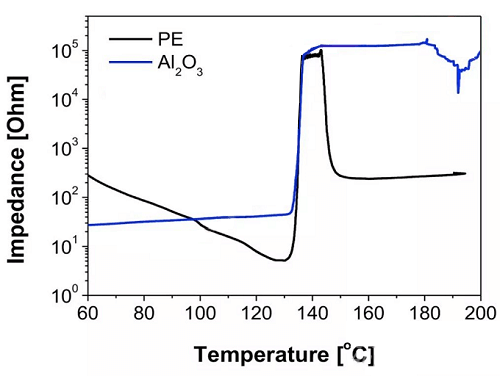
Figure 3. Comparison of the two separator’s shutdown and melting properties.
Enhanced tensile strength and puncture strength
In general, ceramic coating can significantly increase the puncture strength of the separator. To better characterize the differences in the mechanical properties of the separator before and after ceramic coating, the researchers used nanoindentation technology treatment to test both separators.
First, the force-displacement curve shows that both separators exhibit unique properties of viscoelastic materials. Similarly, after 10 min treatment at 200 °C, the surface roughness of the ceramic-free PE separators increased significantly, while no significant change was observed in the Al2O3-coated diaphragm (Figure 4).

Figure 4. (a) Schematic diagram of nail penetration test; (b-c) PE separators, Al2O3 coated PE separators nail penetration test results.
After the two separators were placed at a 200 °C environment for 10 min, the hardness of the ceramic-free PE separators and ceramic-coated PE separator was 126±11 MPa and 374±20 MPa, respectively. Higher hardness means better puncture resistance of the separators, significantly affecting the battery’s performance when needed.
Ceramic coating can improve the separator’s puncture resistance, thus preventing the short circuit caused by the long-term cycle of lithium dendrites piercing the battery’s separator. At the same time, it can neutralize a small amount of HF in the electrolyte to lower the battery’s gas expansion risk.
Improved electrical performance
In applying separators, we should consider improving battery safety while avoiding adverse effects on electrical performance. Figure 5 shows that batteries using Al2O3-coated separators outperform batteries using ordinary PE separators in terms of cycle performance and DCR growth.
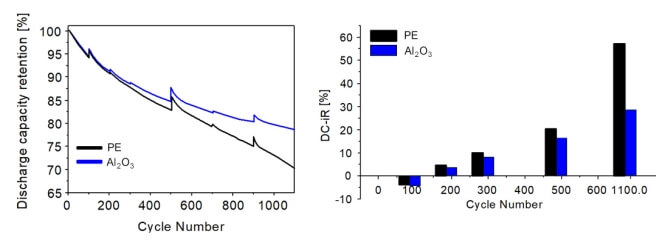
Figure 5. The effect of two separators on battery electrical performance.
Manufacturers use Al2O3, silica, magnesium oxide, calcium oxide, and other ceramic particle materials for coating. Among them, the production process of aluminum oxide ceramic (Al2O3) coating is the most mature and widely used. The main reason is it’s easier to get Al2O3 nano-scale particles, which do not require further grinding processing. Besides, Al2O3 particles disperse better when preparing the ceramic slurry.
In Comparison, other ceramic materials may have poor dispersion and require further grinding. Moreover, other ceramic coating materials have higher process requirements for coating.
Conclusion
In addition to the single-layer coated separators, some manufacturers are also developing multi-layer composite membranes for higher stability, wettability, and lithium-ion conduction capacity. The basic idea of this type of battery separator is to apply two or more layers of coating materials on the base film to achieve excellent composite properties.
In the future, the development direction of power batteries will focus on better safety performance, high output, high capacity, and fast charging mode. The separator coating technology and process requirements will be more diversified, and the continuous innovation of the formula will also become the core competitiveness of the coating companies.
YOUME is a Chinese manufacturer that produces battery separators with functional coating. If you are interested in our ceramic coated battery separator, please learn more about our product.
REFERENCES
–Bokyung Jung, Byungmin Lee, Yong-Cheol Jeong, Joowook Lee, Seung Rim Yang, Hana Kim, Myungkook Park. Journal of Power Sources 427 (2019) 271-282.


